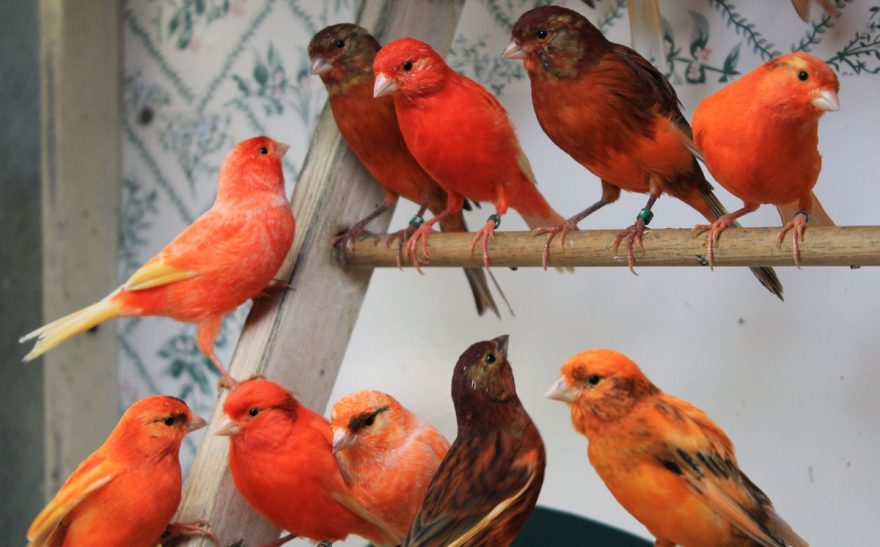The red factor canary is a popular pet bird, kept for the novelty of their vivid red plumage. Aside from their color, they are essentially identical to the ordinary Domesticated Canary, but tend to be worse singers, more difficult to breed, and more expensive to buy.

Let’s look at the three most commonly asked questions about red factor canaries:
Where did they come from?
Red factor canaries were first produced in the 1920s by crossing domesticated yellow canaries with Red Siskins. The domesticated canary was produced two centuries earlier through selective breeding of the Atlantic canary.
In modern times, the red coloring is maintained through selective breeding of canaries that possess the red color genes. Red siskins are no longer required, and after generations of outbreeding, red canaries possess very little siskin DNA.
How is the red color maintained?
Red factor canaries get their color from carotenoid pigments, which are carried via the bloodstream and absorbed by growing feathers — giving them the distinctive red coloration. Carotenoid pigments are introduced into the canary’s system through their food. Offering birds a diet specifically designed to maximize a specific colour is known as “color feeding.”
Color feeding was traditionally done by offering foods that are high in red carotenoid pigments. Carrots, broccoli, kale, and other red bird-safe fruits and veggies are commonly given. Commercially produced “red factor canary seed” can also be used. These are ordinary seed mixes that have been infused with a colour enhancing chemical—typically Canthaxanthin. Liquid colour enhancers that are mixed with the bird’s drinking water are also available but are rarely recommended by breeders.
Color-feeding is most effective while the canary is experiencing its annual feather molt.
Are they compatible with yellow Canaries?
Red canaries and yellow canaries can be housed together without incident. They can breed together too, but doing so is generally advised against as the resulting offspring have diluted feather coloring. Specific canary breeding and compatibility information is available in our species profile.
If there’s anything you want to know about red factor canaries, don’t hesitate to ask in the comment section below.
Is the red factor gene dominant or recessive?
I could be wrong, but I believe the color factor gene is recessive while the color intensity/melanin genes are dominant. So the correct answer is “a bit of both.”
Why are my red canary’s feathers white at the roots?
What you’re describing sounds like either frosted feathers (which is a genetic factor causing the lipochrome pigment to not reach the very tip of the feathers) or overly prominent down feathers.
Australian canaries are starting their moult right about now, so you’re probably seeing some extra white feathers as the older coloured feathers are replaced.
Thank you, he has just started moulting, the first since I have had him which is only a few weeks.
Another thing, my canary was lying on the floor of the cage with his wings outspread, in the end I sprayed him with water and he recovered, was it heatstroke? he seems fine now.
How long does moulting last. Is it common that they stop singing when moulting?
Can they survive in high temperatures or humidity
Within reason, yes. The mix of warmth and moisture makes it more difficult to fight off disease though.
Can you breed a red factor male and a yellow canary and colour feed the babies what colour would you get
Can siblings breed , the shop I bought them from said it is all a myth ?